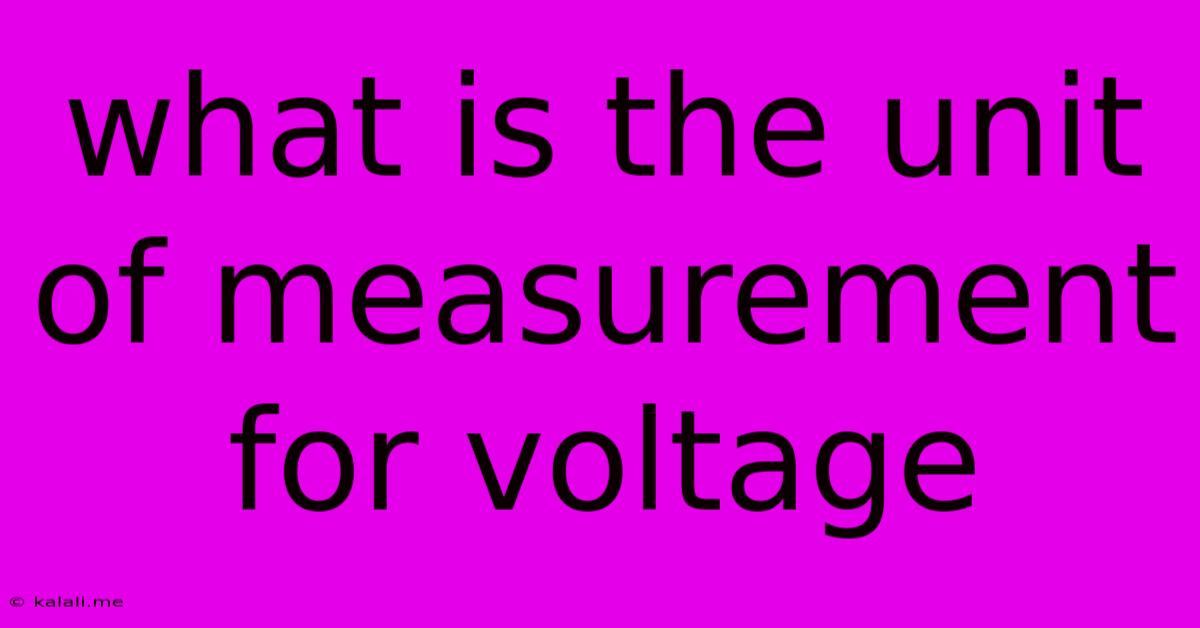What Is The Unit Of Measurement For Voltage
Kalali
Jun 14, 2025 · 2 min read

Table of Contents
What is the Unit of Measurement for Voltage?
Voltage, also known as electromotive force (EMF), is the pressure from an electrical circuit's power source that pushes charged electrons (current) through a conducting loop, enabling them to do work such as lighting a lightbulb. Understanding the unit of measurement for voltage is crucial for anyone working with electricity, from electricians to electronics enthusiasts. This article will delve into the specifics of voltage and its measurement.
The unit of measurement for voltage is the volt, symbolized by the letter V. This fundamental unit is named after the Italian physicist Alessandro Volta, who invented the voltaic pile, one of the first electrical batteries. One volt is defined as the difference in electric potential between two points of a conducting wire when an electric current of one ampere dissipates one watt of power between those points. This definition links voltage directly to power and current, two other essential electrical concepts.
Understanding Voltage in Simple Terms
Imagine voltage as the water pressure in a pipe. The higher the pressure, the faster the water flows. Similarly, a higher voltage means a greater push of electrons through a circuit, resulting in a higher current. However, just like a high-pressure pipe needs a strong pipe to contain the water, high voltage requires proper insulation and safety precautions to prevent accidents.
How is Voltage Measured?
Voltage is typically measured using a voltmeter. Voltmeters are connected in parallel across the component or circuit whose voltage needs to be measured. This is unlike measuring current, where an ammeter is connected in series. Different types of voltmeters exist, from simple analog meters to sophisticated digital multimeters capable of measuring various electrical parameters, including voltage, current, and resistance. The specific type of voltmeter used depends on the application and the level of precision required.
Different Voltage Levels: From Millivolts to Kilovolts
The magnitude of voltage can vary widely depending on the application. We encounter a range of voltage levels in everyday life and specialized applications:
- Millivolts (mV): Used in low-power circuits like those found in sensors and integrated circuits. A millivolt is one-thousandth of a volt (1 mV = 0.001 V).
- Volts (V): Common in household appliances and electronic devices, ranging from a few volts to several hundred volts. Examples include batteries (1.5V, 9V, etc.) and mains power (120V or 230V depending on region).
- Kilovolts (kV): Used in high-voltage applications like power transmission lines and some specialized equipment. A kilovolt is one thousand volts (1 kV = 1000 V).
Understanding the unit of measurement for voltage – the volt – and its various scales is fundamental to comprehending and working safely with electrical systems. Whether you are dealing with a simple battery or a high-voltage power line, always prioritize safety and use appropriate measuring instruments and precautions.
Latest Posts
Latest Posts
-
How Many Chambers In A Fish Heart
Jun 15, 2025
-
Give A Suitable Title To The Passage Answer
Jun 15, 2025
-
Letter Format For Bank Account Closing
Jun 15, 2025
-
The Asteroid Belt Lies Between The Orbits Of
Jun 15, 2025
-
Milk Of Magnesia Base Or Acid
Jun 15, 2025
Related Post
Thank you for visiting our website which covers about What Is The Unit Of Measurement For Voltage . We hope the information provided has been useful to you. Feel free to contact us if you have any questions or need further assistance. See you next time and don't miss to bookmark.